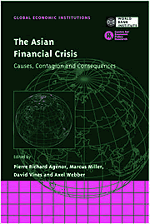Book contents
- Frontmatter
- Contents
- List of figures
- List of tables
- Preface
- List of conference participants
- Acknowledgements
- List of abbreviations and acronyms
- Introduction
- Part One General Accounts
- Part Two Theoretical Contributions
- Part Three Contagion
- 8 Contagion: monsoonal effects, spillovers and jumps between multiple equilibria
- Discussion
- 9 Contagion and trade: why are currency crises regional?
- Discussion
- 10 Competition, complementarity and contagion in East Asia
- Discussion
- Part Four Policy Responses
- Index
9 - Contagion and trade: why are currency crises regional?
from Part Three - Contagion
Published online by Cambridge University Press: 26 February 2010
- Frontmatter
- Contents
- List of figures
- List of tables
- Preface
- List of conference participants
- Acknowledgements
- List of abbreviations and acronyms
- Introduction
- Part One General Accounts
- Part Two Theoretical Contributions
- Part Three Contagion
- 8 Contagion: monsoonal effects, spillovers and jumps between multiple equilibria
- Discussion
- 9 Contagion and trade: why are currency crises regional?
- Discussion
- 10 Competition, complementarity and contagion in East Asia
- Discussion
- Part Four Policy Responses
- Index
Summary
Introduction
The ‘Asian flu’ of 1997–8, the Mexican meltdown and ‘Tequila hangover’ of 1994–5, and the European Monetary System (EMS) crisis of 1992–3 are three samples of speculative attacks on fixed exchange rate regimes. These currency crises generally involved countries in the same region. Once a country had suffered a speculative attack – Thailand in 1997, Mexico in 1994, Finland in 1992 – other countries in the same region were disproportionately likely to be attacked themselves.
Why? One explanation is that currency crises tend to spread through a region because countries are linked by trade, and trade tends to be regional. Once Thailand floated the baht, its main trade competitors (for example, Malaysia and Indonesia) were suddenly at a competitive disadvantage, and so were themselves likely to be attacked. The spread of currency crises thus reflects international trade patterns: countries that trade and compete with the targets of speculative attacks are themselves likely to be attacked.
Prima facie, then, trade linkages seem like an obvious place to look for a regional explanation of currency crises. But most economists think about currency crises using variants of two standard models of speculative attacks. The ‘first-generation’ models of, for example, Krugman (1979) direct attention to inconsistencies between an exchange rate commitment and domestic economic fundamentals such as an underlying excess creation of domestic credit, typically prompted by a fiscal imbalance. The ‘second-generation’ models of, for example, Obstfeld (1986) view currency crises as shifts between different monetary policy equilibria in response to self-fulfilling speculative attacks.
- Type
- Chapter
- Information
- The Asian Financial CrisisCauses, Contagion and Consequences, pp. 284 - 306Publisher: Cambridge University PressPrint publication year: 1999
- 8
- Cited by



